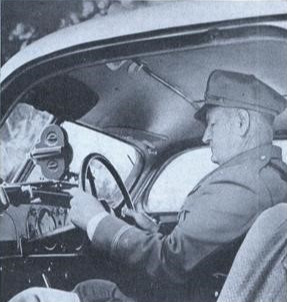
 In 1939, Officer R. H. Galbraith (pictured right) of the California Highway Patrol mounted his own motion picture camera on the dashboard of his patrol car to take photos of the vehicles he followed during his patrols and provide backup evidence in court for the tickets he wrote.
In 1939, Officer R. H. Galbraith (pictured right) of the California Highway Patrol mounted his own motion picture camera on the dashboard of his patrol car to take photos of the vehicles he followed during his patrols and provide backup evidence in court for the tickets he wrote.
Since Galbraith’s innovative use of cameras over 80 years ago, safety cameras are rapidly becoming a staple of not just law enforcement but also any industry relying on fleets and transportation to conduct daily business. The uses of safety cameras in commercial vehicles are many:
- Promoting driver awareness of unsafe or distracted driving behaviors
- Reducing the number of safety-related incidents
- Evidence of circumstances and environment in the case of motor vehicle accidents
As with most new technology, however, the question of cost and ROI is often of foremost concern for those tasked with managing and paying for safety camera solutions. Fortunately, safety cameras have a remarkable record of saving not just lives, but money.
Fewer accidents
A study by the FMCSA1 showed that over a 13-week period, in-cab safety cameras without driver alerts for certain behaviors (phone use, drowsiness, etc.) brought about a 38% reduction in safety-related events. Adding driver awareness alerts and coaching—such as through driver scorecards—brought the reduction to 52%. According to the Insurance Institute for Highway Safety4, rear cameras show a 17% decrease in crashes involving vehicles backing up or maneuvering in reverse.
In other words, having safety cameras means fewer accidents, even if no further safety training is conducted.
Even a single accident can have a devastating financial impact on a company. According to the National Safety Council2, the cost per medically consulted injury in 2021 was $42,000, while the cost per death was $1,340,000. Total motor-vehicle injury costs were estimated at $498.3 billion (about $1,500 per person in the US)3. Costs include wage and productivity losses, medical expenses, administrative expenses, motor vehicle property damage, and employer costs.
Internal data from Tenna customers backs up research showing safety improvements after the installation of cameras. Within 30 days of installing cameras, average driver safety scorecards improve by +20 points, with an average of three fewer safety events—including speeding and harsh braking—per day per driver. Across a fleet of 50 vehicles, a ten-point driver safety score improvement correlates with one less time-loss vehicle incident per month.
.jpg?width=600&height=315&name=TennaCAM_2.0_Infographic_1200x630%20(002).jpg)
Exonerating evidence and swift litigation settlements
In January 2021, a motor carrier in Texas successfully obtained the dismissal of a personal injury lawsuit in federal court after submitting safety camera footage of the accident. The company was sued for $150,000 after the plaintiff claimed the driver swerved out of his lane and struck the other vehicle. According to attorney David Helmey, the total cost of the defense was less than $5,000.6
“Even when cases are not dismissed early, dash camera video of an incident can significantly decrease the cost of defense,” said Helmey. “When defendants have video evidence showing conclusively what happened in the accident, this can reduce the number of disputed issues and narrow the scope of what the plaintiff’s attorney is allowed to explore in discovery.”
Reducing insurance costs
Joel Baker, an owner-operator with over 40 years of experience in transportation and a licensed insurance agent, listed key factors7 for companies to consider when trying to lower insurance premiums:- Have a clean motor vehicle record for your drivers.
- No distracted driving, failure to yield/stop, speeding over 25 mph, or at-fault rear-end accidents.
- No auto insurance liability or physical damage claims.
Baker doesn’t mention safety cameras specifically because few, if any, insurance companies list specific discounts just for having a camera present. There is an abundance of anecdotal evidence that insurance carriers are willing to negotiate discounts for fleets with safety cameras, and some carriers are beginning to consider formulaic premium decreases factoring in the presence of cameras.8 The reason for this is the factors that help determine insurance premiums and the degree to which camera footage can help mitigate those risks.
As noted earlier, the presence of cameras helps to improve drive safety scores and reduce accidents. The camera footage also helps exonerate drivers, dismiss lawsuits, and speed up and simplify settlement claims—all factors that weigh positively in lowering insurance costs.
Another way safety camera footage can help is in improving CSA BASIC scores. The Federal Motor Carrier Safety Administration (FMCSA) uses seven categories in its Compliance, Safety, and Accountability (CSA) program to categorize carriers for safety:
- Unsafe driving
- Crash indicator
- HOS compliance
- Vehicle maintenance
- Controlled substances/alcohol
- Hazardous materials compliance
- Driver fitness
Data collected through roadside inspections, crash reports, investigations, and other violations over a 12-month period are ranked per category and compiled into a company’s BASIC score. Insurance companies review BASIC scores as part of their overall fitness and risk evaluations.9 The FMCSA has a Crash Preventability Determination Program to evaluate whether crashes on a company's record were from driver error or outside of the driver’s control.10 Submitting camera footage as part of the evaluation process ensures that accidents where drivers are not at fault do not count against the company’s BASIC score, and do not contribute to higher insurance rates.
Maintenance and fuel savings
According to the Department of Energy, aggressive driving (speeding, rapid acceleration, and braking) can lower gas mileage by roughly 15% to 30% at highway speeds and 10% to 40% in stop-and-go traffic.12 However, a study by the Institute of Transportation Studies found that in-cabin feedback on driving behavior that affected fuel consumption resulted in a 2.7% reduction in fuel use.11 Using safety cameras to coach drivers and evaluate routes based on monitoring traffic from video footage can result in savings of $0.36–$1.44/gallon (based on a cost of $3.60/gallon).
Video footage can also reveal where aggressive driving techniques, such as hard accelerating or braking, put more stress on the vehicle overall. Driving at high speeds is hard on the transmission. Taking turns too causes more rapid and uneven wear on tires, and strains the alignment, shocks, and suspension. Harsh braking is, obviously, damaging to the brakes and to the tires. If preventative maintenance programs are turning up issues that involve more than the expected wear and tear, camera footage can help identify drivers in need of coaching and problematic routes for traffic causing extra starts and stops.
Conclusions
Incorporating safety cameras into a telematics-based fleet management program is an excellent and engaging way to not only improve driver safety but also to see significant cost savings across the organization. Tenna customers report that the feedback alerts from cameras, along with the interactive improvements in driver scorecards, make their drivers partners in the solution to improve safety and see financial gains. Robert B. Our Company reported, “The drivers love to go back and look at potential accidents and near misses. Some person cut them off on the highway, and they love to be able to show people how they stopped an accident from happening.” The ROI from investing in safety cameras far exceeds the costs of implementing the system.
Resources
- https://rosap.ntl.bts.gov/view/dot/61
- https://injuryfacts.nsc.org/work/costs/work-injury-costs/
- https://injuryfacts.nsc.org/motor-vehicle/overview/introduction/
- https://www.iihs.org/media/290e24fd-a8ab-4f07-9d92-737b909a4b5e/oOlxAw/Topics/ADVANCED%20DRIVER%20ASSISTANCE/IIHS-HLDI-CA-benefits.pdf
- https://fuentesfirm.com/wp-content/uploads/2021/01/2021-01-22-Redacted-Order-Granting-MSJ.pdf
- https://fuentesfirm.com/negligence-claims-against-trucking-company-driver-dismissed-based-on-dash-camera-video/
- https://www.overdriveonline.com/overdrive-extra/article/15288488/how-do-insurers-calculate-our-trucking-insurance-premium-rates
- https://www.jdsupra.com/legalnews/can-cameras-in-fleet-vehicles-lower-8029826/
- https://www.freightwaves.com/news/2018/1/4/csa-scores-and-their-impact-on-carrier-insurance-costs
- https://eld.kellerencompass.com/resource/blog/fmcsas-crash-preventability-determination-program-relaunched
- https://www.fueleconomy.gov/feg/pdfs/EcoDrive%20I-80.pdf
- https://www.fueleconomy.gov/feg/driveHabits.jsp
About Austin Conti
As CEO and Co-Founder of Tenna, Austin leverages his international experience in construction operations for civil, building, and energy projects with The Conti Group, which has built successful, reputable businesses that make a positive impact on the world in construction, engineering, renewable energy, real estate, technology, and biotech. His passion for entrepreneurship led him to create a construction technology platform built on over a century’s experience from The Conti Group.
